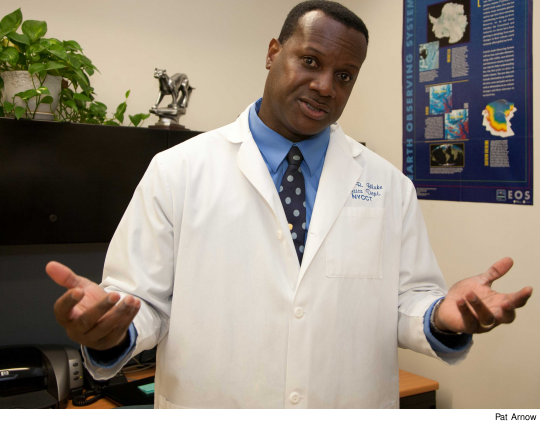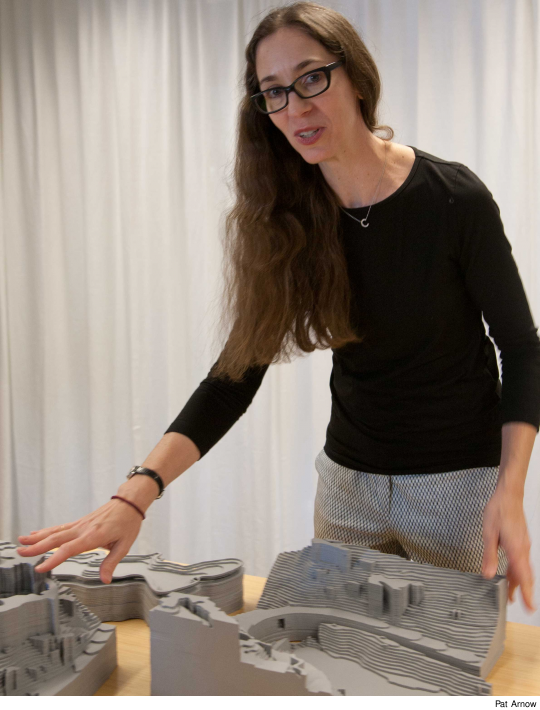Superstorm Sandy highlighted the many challenges posed by human-induced climate change. CUNY faculty, in turn, are helping shape how our society responds with their research, teaching and policy analysis.
______________________________
 |
Reginald Blake
City Tech
Associate Professor of Physics
Reginald Blake decided to study meteorology when he came to the United States as a teenager in 1981, a year after a Category 5 hurricane devastated his native Jamaica. Blake later earned a PhD in geophysics (specializing in hydrometeorology) and went on to become a faculty member at CUNY, where he spends his days reviewing the latest satellite remotely sensed data on storms, vegetation, sea ice, soil moisture, ocean color, air pollution and more. Blake is a member of NOAA-CREST, the National Oceanic and Atmospheric Administration’s Cooperative Remote Sensing Science and Technology Center, a joint project of a dozen colleges and universities that is led by CCNY.
“We use satellites to study the heartbeat of the Earth,” says Blake who works with his fellow scientists to create increasingly sophisticated computer models of future changes in global weather systems.
In 2008 Blake was named to the 13-member New York City Panel on Climate Change (NYCPCC), whose comprehensive 2010 report (“Climate Change Adaptation in New York City: Building a Risk Management Response”) sometimes reads like a news account of Superstorm Sandy’s impact two years later.
As an active member of the NPCC and also of the Climate Change Impacts group at NASA-Goddard Institute for Space Studies at Columbia University, Blake expects New York to become warmer and wetter in the coming century, facing both rising sea levels and increasingly intense storms.
When Blake looks to the future, he also thinks of his own field and the need to replenish its aging ranks with a diverse new generation of scientists. Blake heads the Black Male Initiative at City Tech, the only BMI program at CUNY with a STEM (science, technology, engineering, mathematics) focus.
He is also the principal investigator for two National Science Foundation grants aimed at developing the scientists of the future. One makes possible a yearlong program for CUNY undergraduates who do faculty-supervised research and travel to major conferences with their faculty mentors. Many past participants have gone on to pursue graduate degrees in the sciences, Blake told Clarion. The other program brings the geosciences to life for students at a middle school in Bushwick and two high schools in downtown Brooklyn.
“I’m on a crusade,” Blake says. “This is a great opportunity to capture young minds and teach them about how this dynamic Earth works.”
Marco Tedesco
City College
Associate Professor of Earth and Atmospheric Sciences
Marco Tedesco pitches a tent each summer near the top of the world to study the Greenland ice sheet. The ice sheet, two to three kilometers thick and nearly the size of Mexico, has been frozen in place for millennia – but it is now melting much faster than scientists anticipated even a decade ago.
A full melt of Greenland’s ice sheet would cause sea levels to rise by 23 feet. This is considered unlikely to happen for at least the next couple of centuries, but even a partial collapse of the ice sheet could have an enormous impact around the world.
“If you keep increasing the sea level, you can really be inundated when there is a big storm,” says Tedesco. “Everything adds up.”
For Greenland, this summer was off the charts. At one point in July, 97% of the ice sheet was experiencing melting, a level unprecedented since satellite tracking of the summer melt began in 1979.
“2012 was a Goliath year,” Tedesco says. “It was like a basketball giant walking around Times Square and everyone looking at him.”
This year Tedesco was on the ice sheet for two weeks as a part of a six-person scientific team. They measured the depth of lakes created by the summer melt. They also dug holes in the ice to place antennae that measure how fast the ice sheet is moving toward the sea. For Tedesco, the chance to do this kind of direct research is deeply rewarding.
“Your world is a two-meter by one-meter tent. You can hear the ice breaking,” Tedesco recalled. “It requires so much discipline and so much work. There’s a completely different satisfaction getting your results from the field than from solving a problem at your computer.”
Melissa Checker
Queens College
Associate Professor of Urban Studies
As the modern environmental movement took root in the 1970s and ’80s, cleaning up remaining toxic waste sites became a top priority. Legislation was passed and hundreds of Superfund and other high-priority sites have been designated for cleanup.
In recent years, climate change has absorbed many environmentalists’ attention. When Superstorm Sandy hit, Melissa Checker says, two kinds of environmental crises converged when unrepaired Superfund sites on Staten Island’s North Shore were swamped by the storm surge.
“It’s really scary,” she said of the toxic brew that Sandy spread around.
Checker is author of Polluted Promises: Environmental Racism and the Search for Justice in a Southern Town (NYU Press, 2005). In recent years she has been studying how big, City-backed development projects in New York intersect with community concerns about sustainability and environmental justice. She says it’s important for climate justice activists to make common cause with low-lying communities at risk of seeing toxic spills from an earlier era dispersed into the wider environment by future storm surges.
Checker told Clarion that North Shore residents had repeatedly inquired with City officials in recent years about the threat posed by rising sea levels, but had received only pat answers. In November 2012, in the wake of the storm, North Shore residents turned out in large numbers at a public meeting to denounce City-backed plans for building the world’s largest Ferris wheel on the North Shore as part of a larger hotel and retail complex. Many local residents would rather see public funds used to mitigate the environmental risks they face.
“The storm brought everything into high relief,” says Checker.
Catherine Seavitt Nordenson
City College
Associate Professor of Landscape Architecture
Catherine Seavitt Nordenson’s phone began to ring soon after Superstorm Sandy inundated the New York City area with a 14-foot storm surge. People wanted to talk with her about how New York City could be reshaped to limit damage from such storms in the future.
Seavitt is co-author, with Guy Nordenson and Adam Yarinsky, of the 2010 book On the Water: Palisade Bay, which explores how natural systems could be enhanced to better protect the city from higher sea levels and an increased risk of dangerous storms generated by climate change.
 |
The book in turn spawned “Rising Currents: Projects for New York’s Waterfront,” an exhibition at the Museum of Modern Art that ran for seven months. The exhibit spurred wide public interest, and was visited by a number of local and regional policy makers.
In the wake of Sandy, as debate heats up over whether to build costly sea gates to thwart future storm surges, City and State officials want to know more about Seavitt’s ideas.
She advocates measures such as constructing an archipelago of small islands in the shallow flats of the Upper Bay of New York Harbor, which extends over 20 square miles from the Verrazano Narrows to the Brooklyn Bridge, restoring the region’s once-prolific oyster and mollusk beds to promote wave-attenuating natural reefs, and reestablishing areas of coastal wetlands. “The enhancement of natural ecosystems helps create resilience,” she explains: features like these would act as “speed bumps” and help reduce wave velocity and damage from storm surges in the future.
In her vision, functionality could be wed to beauty with the modified Upper Harbor serving as a park on the water, serving people from across the region. “There are 364 other days a year when we want to be living in a green, wonderful city with a high quality of life,” Seavitt says.
Kim Curran
Bronx Community College Center for Sustainable Energy
Assistant to the Director and Instructor in Photovoltaics
Shifting to renewable forms of energy, like solar and wind, in the coming decades is widely seen as crucial in deciding how much worse climate change is going to get. This transition toward a low-carbon economy in turn creates opportunities for new businesses and “green collar” jobs – and teachers like Kim Curran are opening the doors for students who want to get into these fields.
Curran teaches introductory photovoltaics at Bronx Community College’s Center for Sustainable Energy (CSE), a certificate-granting institution housed on the main BCC campus. CSE’s solar power classes help students master everything from the basics of electricity to how to navigate City regulations that govern solar-power installation. Classes like the one Curran teaches attract people in fields from construction to information technology, looking to take their careers in new directions, as well as students from other nations who are eager to bring solar power back to their own countries.
Curran left her previous career in the telecommunications industry to learn everything she could about solar power. When she’s not teaching, she works as the assistant to the Director of CSE and helps consult students on their career paths and opportunities. Being in solar, she says, gives her the chance to do something “more meaningful.” In Curran’s estimation, solar power is the key energy source for a more sustainable future, even more than wind: “There’s so much more of this kind of energy than anything else,” she told Clarion.
“Most of our students look to this as a new and growing industry that is also the only sensible environmental solution,” adds Curran. “They love what they are doing. It’s a fabulous, fabulous field.”
______________________________
RELATED COVERAGE:
Analysis: Storm Surges and Sea Levels
Viewpoint: Protecting the City from the Sea
CUNY Responds to Sandy: Suffering Spurs Solidarity

